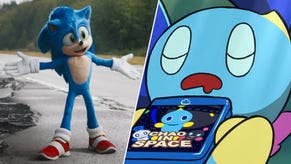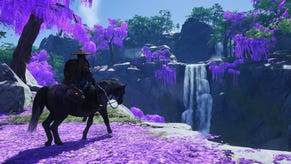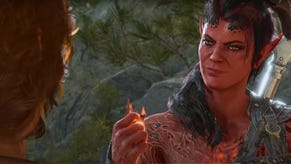GTA 5's biggest score: creating the soundtrack to Los Santos
Producer Oh No takes us through the creation and year's worth of work behind the Grand Theft Auto 5 score.
"Scoring a video game is way more work. Everything has to be exactly right, it has to match visuals. That's a big difference compared to working with an artist who's like 'gimmie a beat for the streets'."
Everyone has their own favourite radio station in Grand Theft Auto. Even the vehicles have their dials pre-set to a particular channel. Steal a mafia Sentinel and you'll hear Double Clef FM as you step over a bleeding goon. GTA's radio stations have been the soundtrack to Vice City, San Andreas and Liberty City.
But when Rockstar reimagined Los Santos and Blaine County for GTA 5 it pushed for an original score that plays more often than any radio station. Just as the radio offers music for every taste, this new soundtrack was designed to capture multiple musical styles, each reflecting the three main protagonists of the game, created by artists with different but complimentary backgrounds.
Hip-hop production duo Oh No and Alchemist were charged with representing the sound of the streets for the youngest character, Franklin. German electronic music pioneers Tangerine Dream captured Michael's midlife crisis and subsequent re-awakening. And long-time Rockstar collaborator Woody Jackson (L.A. Noire, Red Dead Redemption) picked up its most complicated character, the psychopath with mother issues, Trevor Phillips.
"Franklin is heavily into hip-hop so we were knocking that kind of stuff out, Woody Jackson would handle the rock stuff for Trevor and Tangerine Dream did all the ill synths," says Oh No from his studio in Los Angeles.
"The way we worked was everyone was turning in music that we thought would fit without seeing the game. So I was watching videos of Grand Theft Auto 4 and making beats. And then Rockstar got us to hook up with the musicians and just start vibing together with Woody. Then Tangerine would come over and layer it up." The result was then mixed down by DJ Shadow, adding another layer to the first ever full original score in the GTA series.
Oh No's star in hip-hop has been steady rising for over a decade. His musical family includes brother Madlib, but he's long since carved out his own sounds with well-received work (including the Gangrene project with Alchemist) as well as material from De La Soul, Guilty Simpson and MF DOOM.
While Oh No clearly holds hip-hop chops he's also a full-on video game player, something that bubbled up in The Ride, a track constructed entirely from video game samples. "I'm a big gamer so anytime a video game is involved I'm 1,000 percent behind it. I'm a bigger gamer than a musician at times," he says.
GTA 5 wasn't Oh No's first time working with Rockstar. Partner Alchemist - who worked on GTA Chinatown Wars - introduced Oh No to the studio, and he ended up laying down drum tracks on Red Dead Redemption: Undead Nightmare. Drums are central to any hip-hop record, but scoring a game is a far cry from knocking together a head-nodding track on demand.
"Undead Nightmare helped me do Grand Theft Auto 5, because there were a lot of drums I had to switch and change up in that," he says. "Scoring a video game is way more work. Everything has to be exactly right, it has to match visuals. That's a big difference compared to working with an artist who's like 'gimmie a beat for the streets. I want something to ride to.' That beat might only have eight elements in it compared to a score that brings in strings and horns and then different musicians making it extra big on top."
Part of the difficulty was working in the dark during those early stages, says Oh No. While GTA 4 acted as a substitute to begin with, finally seeing GTA 5 helped to bring the sounds together. Those different elements needed to work as a cohesive whole, but also when pulled apart and played independently to reflect the changes in dynamic gameplay.
"We had a meeting and Rockstar showed us some videos. From there we knew where we had to go with it. We were working on music that was super-dark. Once we saw exactly what they needed we realised it had to be more structured. When I'm making a beat at first it might have 20 elements in it, but when it's finished there might be 100 elements in that beat.
"Rockstar would call up and say 'we've got this scene where you're driving and you have to take the car offroad to a boat. So we need a water beat.' I'm making all these musical elements that can be played together or played apart, and at any time. About halfway into it we got to fly to New York and play a bunch of missions and see how it worked. From that I knew exactly what I needed to put here and there."
"For certain missions I would listen to old soundtracks. 48 Hours, A Clockwork Orange, crazy movies with ill scoring. It had me listening to all kinds of stuff from the 70s and 80s."
The complicated and changing nature of the score made it a big project. Oh No estimates he made around 130 different tracks overall. "At least ten of them got fully fleshed out," he says. "Within those ten beats there's another ten beats. So you play them and there's multiple drum tracks. It was literally a year's worth of work. From 6 am to 3 am non-stop."
It wasn't just Oh No's hip-hop knowledge that was channeled through the score. As with any musical project for Rockstar, there's influences from different decades and genres in the overall sound.
"For certain missions I would listen to old soundtracks," he says. "48 Hours, A Clockwork Orange, crazy movies with ill scoring. It had me listening to all kinds of stuff from the 70s and 80s.
"But once we had a bunch of dark beats we'd realise we also needed something funky. So I'd try to channel some Fred Wesly with a little Van Halen and some Parliament. And that's how I would make the beat - go into the mindstate with those in my head."
Since scoring the game, Oh No and Alchemist have put together a brand new radio station for the PC release, called The Lab.
"The radio stations are definitely a massive plus," he says. "It's one of my favourite things about GTA.
"When you're driving you want to be comfortable and listen to the kind of music you want to hear. They have so many different genres of music as well as talk radio. You can drive through a whole city and just trip off it. It sets the tone as much as the story."
Rockstar's love of music has always been evident in the radio stations it creates. It has iconic performers hosting the shows - from Public Enemy's Chuck D to Circle Jerks' Keith Morris - and not only includes genre-defining tracks but also the original music that inspired them. It's a history lesson as much as a mirror to current tastes.
"Their whole team is so diverse and they know music," says Oh No. "They know what's current, they know what's classic, they know what's popular.
"They know it like they know their games."
The Alchemist and Oh No present: Welcome to Los Santos is available on CD, vinyl and digital formats from April 21.










.jpg?width=291&height=164&fit=crop&quality=80&format=jpg&auto=webp)
